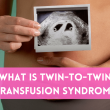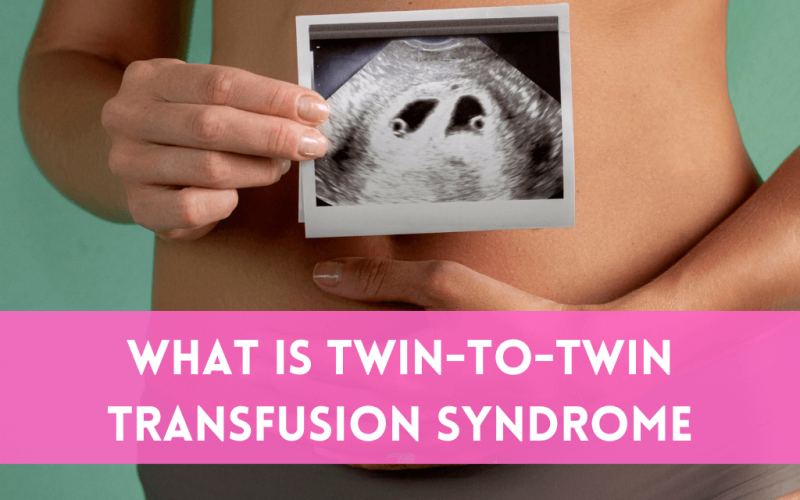Most twin parents hear about the condition Twin-to-Twin Transfusion system from their doctors as a potential threat during pregnancy. The condition isn’t common, but it is an extremely complicated and dangerous one that parents should look out for. There is certain treatment and diagnosis made only for this condition too. Therefore, potential twin parents must have a clear idea of the disease.

What is Twin-to-twin Transfusion Syndrome
Twin pregnancies come with a lot of joy as well as complications. Parents have to look out for rare conditions. One of them is twin-to-twin transfusion syndrome. Although it is not as common in any kind of pregnancy, it still poses a risk to all pregnant moms be it singletons or twins.
Describing TTTS is just as complicated as the disease itself. It needs a lot of scientific explanations and descriptions. And the reason for that is a severe and complicated disease needs elaborated explanations to make it more comprehensive.
The condition TTTS is usually seen in a specific type of twin pregnancy. It is called monochorionic pregnancy. In this type, the twins share the same placenta which is why they have a shared blood vessel connecting both of them on the placental surface. Blood vessels are responsible for carrying nutrients and oxygen in the womb for the babies that help them develop and grow.
It needs to be noted that identical twins also have the same placenta since they derive from a single egg. Among all the identical twin pregnancies, TTTS is seen among 10-15% of them. Therefore, TTTS doesn’t affect the nonidentical twins because they don’t have the shared placenta which is a prerequisite for the TTTS condition. In medical science, nonidentical twins are called fraternal twins.
In normal cases of identical twins, they share a placenta but they also have a normal blood flow through the vessels which is equally divided between them. Through this blood flow that the vessels carry, twins can grow and develop normally. But in the case of TTTS, there is an imbalance in the blood flow through the vessels.
The flow gets disrupted and loses equal balance. As a result, we observe one baby getting way more blood than the other one. In the medical field, they phrase it as one baby donating its portion of blood to the other one. As you can tell from the situation, it brings some consequences to the twins and their health. The twin donating blood, who is called the donor twin who is donating blood to the other one, doesn’t get enough blood or water for himself or herself.
The baby, therefore, gets dehydrated and can’t produce enough urine. The amniotic fluid in the donor twin’s body decreases abnormally. Amniotic fluid is very important for the growth of a fetus. It creates a soft liquid surface surrounding the baby, protecting babies in the womb. When the donor twin gets dehydrated and loses the important fluid, it is more at risk of getting injured or developing some other disease.
The other twin is called the recipient twin in medical science because it receives more than the normal amount of blood. This twin also faces consequences because of the excess blood in its system. Excess blood creates more than enough amount of urine which is responsible for the excess amount of amniotic fluid in the body.
The excess amount of blood increases the risk of heart attack, and heart damage and eventually pushes the babies to fatal diseases. An unequal amount of blood creates issues for both of the babies.
Donor twins can’t develop important organs at the rate they should. Recipient twins face complicated issues in their organs. All these consequence puts more importance on getting the treatment. This is where we have the good news that treatment is available for this disease.
Exceptional Case of TTTS
There is another version of TTTS which is called Twin Anemia Polycythemia Sequence or TAPS. It is where the vessels transfer an excess number of blood cells instead of an excess amount of blood. As a result, the amount of amniotic fluid stays in the normal range.
However, the excess amount of red blood cells creates other issues in the twins’ bodies. The reason why TAPS happens is that the blood vessels that are responsible for carrying blood between the twins are very small or narrow.
Therefore, they only carry blood cells. But the consequence is just as risky if not more than an excessive amount of blood in the body. In the case of TAPS, the recipient baby’s blood thicken due to an increased number of blood cells. This can block the arteries in the heart and lead to immediate cardiac arrest.
This particular condition is called polycythemia which is also included in the abbreviation of TAPS. And the twin that doesn’t receive as many red blood cells might develop severe conditions like anemia which is a lack of red blood cells in the human body. Even if these conditions might not be fatal in the womb, being born with an imbalance will create long-term problems after the twin’s birth.
What Happens to the Donor Twin
A condition like this creates a chain reaction in the baby’s body. To understand how it works we can go deep into the detail of it. The donor twin that gives out blood, experiences a huge loss of blood. It is known as hypovolemia. You might have heard this name in people who die from losing too much blood after an accident. The body goes into shock at the sudden decrease of blood and organs stop working.
The body might even die. In this case, the organs also stop functioning the same way. When the baby keeps losing blood, over time kidneys don’t get enough blood to filter so the baby also stops producing urine. Lack of urination prevents the bladder from being developed and as a result, there is also a lack of amniotic fluid. Now, the amniotic fluid is full of fetal urine which provides the baby in the womb a cushion.
The fetus also consumes the fluid as it grows in the womb. The fluid contributes to the development of the urinary, gastrointestinal system, respiratory, etc. But when the fluid is absent the fetus develops other conditions related to these organs. One such is oligohydramnios- it happens when there is a reduction of the fluid. When the fluid completely disappears it is known as anhydramnios.
While these conditions keep developing there is also a huge risk – cardiovascular dysfunction. The blood volume becomes too low to enter the donor twin’s circulatory system. It doesn’t reach the body and so the heart can’t function as well. In the end, the donor twin faces the risk of death.
Analyzing the Condition for the Recipient Twin
The recipient twin faces consequences exactly the opposite of the donor twin. The recipient baby is at risk because of the increased blood volume. The condition is called hypervolemia. It is when the blood volume successively increases. This can also lead to frequent urination.
Because there is too much blood in the system the kidney overloads and filters way more blood than it should. As a result, there is much more amniotic fluid.
The bladder keeps getting filled. Every time the bladder gets emptied it gets filled by more urine. So the baby faces polyhydramnios. It is when there is an excess or abnormal increase in amniotic fluid.
When the situation is consistent and happens for a prolonged time it affects the heart muscle in the recipient twin. Because there is too much blood in the system, the tiny heart gets tired of pumping way more blood than it can. The huge amount of blood exceeds the capacity of the heart and the blood vessels. It can also lead to cardiovascular dysfunction and eventually end in death.
Different Stages of TTTS
Stage 1 – In the first stage we see two conditions in both twins – polyhydramnios and oligohydramnios. It is when there is too much amniotic fluid in one twin and too little or an absence of amniotic fluid in the other twin.
Stage 2 – In this stage, we observe that the donor twin’s bladder is not emptying as much as it should. This happens because the blood is being transferred from the kidney to other organs like the brain, adrenal glands, and heart. It happens due to the donor twin’s body being in survival mode.
The body is now trying to preserve the organs and keep normal functioning going even though it is struggling. The only two functioning organs are the kidney and the bladder. However, the bladder is getting slower as it is not emptying.
Stage 3- In this stage of TTTS, the functions get very complicated. There is an abnormal blood flow in the body that also includes reversed flow in DV or ductus venous.
On top of that, there is either absent or reversed umbilical artery end-diastolic velocity known as UAEDV. This abnormal pattern of blood flow indicates that one of the twin’s hearts is being affected. The increase or the decrease in blood volume has affected their tiny hearts already in the third stage.
Stage 4 – In this stage of TTTS, massive fluid retention happens. This is quite serious as it puts the mother of the twins at risk as well as the twins. It is also known as hydrops. It indicates that the recipient twin’s heart has failed or there has been a cardiac arrest of the baby. The heart couldn’t pump the high volume of blood that was sent from the donor twin.
Diagnosis

After all the traumatic signs and symptoms of the disease, there is a ray of hope that if it’s diagnosed it can be treated. However, the first step is diagnosis.
Another reason why it is essential is because experts need to distinguish TTTS from other diseases such as selective fetal growth restriction. This disease and TTTS happen in monochorionic diamniotic pregnancies but can be differentiated through the level of fluid and bloodstream. There are several ways to get it diagnosed
High-resolution Ultrasound
Ultrasound can rule out all the structural problems in babies. It can give you results on whether the placenta is in the right place, and whether the umbilical cord is rightly inserted into the placenta, and it can also evaluate the amniotic fluid level in the womb. Along with those, the ultrasound will also give you a report on whether the blood flow patterns in normal and assess blood vessels for each of the twins.
Fetal Echocardiogram
As you can already tell from the name, it is to evaluate the heart condition. It is also one type of ultrasound that can asses the twins’ hearts to see if there is any heart condition. The TTTS condition affects the recipient’s heart the most. It puts serious strain on the recipient twins heart which causes the heart to enlarge and dysfunction.
Doctors usually recommend all TTTS twin cases go through an echo diagram to asses if the hearts are affected or not. In this diagnosis, experts develop a tool to see the severity of the heart condition of the twins.
Based on this result, the doctors determine whether they need treatment or not. There is also a study based on the severity that you can read to learn further on the topic. You can find more research findings and treatments like this in a book dedicated to all twin pregnancy research here.
Genetic Amniocentesis
It is a procedure to test the amniotic fluid and assess the current condition. In this process, a small amount of fluid will be taken from the sacs around both of the fetuses. It is also counted as a secondary test to confirm any kind of structural malformations along with TTTS conditions.
Treatment
Treatment depends on the stage and severity of the condition. But there are a few that is offered at hospitals
Monitoring the Mother
In cases where the condition hasn’t reached the risky stage, experts don’t recommend surgery. But they run ultrasound and echocardiography to monitor the twins and the pregnancy. A close look and monitoring of the pregnancy detects an escalation or worsening of the situation and take further steps to discuss with the patient and family.
Reducing Excess Amniotic Fluid
The name is pretty self-explanatory. But this can be recommended in mild severity of the cases. Draining excess amniotic fluid will save the recipient from getting cardiac arrest. But in some cases, this process might not work then they will be referred to something else. Known as SFLP, laser surgery might save both babies.
Laser Surgery
When the condition gets severe doctors go for laser surgery. The doctors make an incision in the mother’s abdomen and insert a metal tube into the uterus. They try to find the blood vessels and then fix them with the tube. The laser might also disconnect them permanently.
You can find more treatment options in this video made by the Children’s Hospital of Philadelphia
Conclusion
Since treatment and diagnosis are available, parents shouldn’t worry too much about this condition. Regular check-ups and early diagnosis can cure the patients without causing too much hassle. Twin pregnancies usually are more prone to risk than singletons. So parents need to be cautious throughout the pregnancy.








